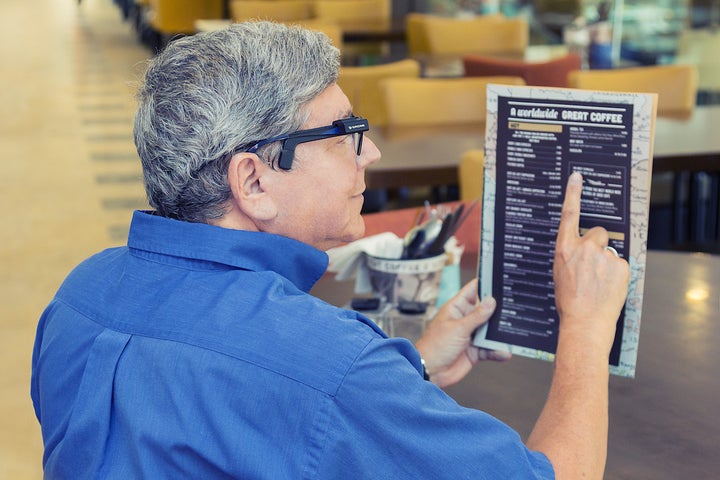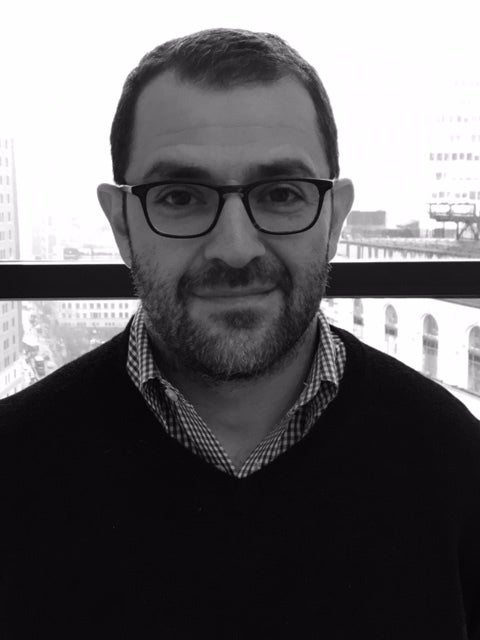
Person using OrCam’s MyEye to read a menu.
New technologies are rapidly changing how many of us live our lives. Advances in connectivity are allowing us to access and transmit information faster than ever before. From financial services to healthcare to education, the application of new technologies is simplifying long-existing processes and changing how consumers interact with businesses and service providers.
Although new technologies are undoubtedly changing our commercial interactions, the application and proliferation of new technologies like Artificial Intelligence (AI) are having a much broader and positive impact on society. However, much of the focus on Artificial Intelligence (AI) has been on how its commercialization will impact the global labor force. Without question, the development and design of systems, machines, and processes that will effectively carry out tasks previously reserved to humans, ranging from decision making to the manufacture of products, will have far reaching implications on our societies and deserves much discussion. Yet, what is equally as impactful and worthy of discussion is the role AI can play in improving the quality of life of everyday individuals.
As many would agree, self-driving cars or automated vehicles are one of the most exciting AI innovations of the 21st century. Powered by advanced AI technology that senses, processes, reacts and adapts to external factors in much the same way a human driver would, self-driving cars are expected to revolutionize human transportation. In terms of safety alone, AI not only predicts and anticipates responses, but can also prevent and mitigate the consequences of bad weather or collisions. Consequently, the future proliferation of automated vehicles is expected to reduce accidents, cut greenhouse emissions, and even increase human productivity.
Now imagine adapting the very same highly advanced AI technology that powers automated vehicles to applications that will improve the lives of the visually impaired. By applying technology that accurately senses its external environment and makes accurate, split second decisions to aid visually impaired individuals you could have a transformational impact on people’s lives.
Recognizing the life-changing implications AI could have for the visually impaired, Israel based OrCam has made it its mission to use AI technology and software to improve the lives of the world’s 285 million blind and visually impaired persons. As the brainchild of Amnon Shashua and Ziv Aviram, cofounders of pioneering collision avoidance technology company Mobileye, OrCam’s flagship product, MyEye, uses advanced AI technology to help the visually impaired recognize faces, read words and text, identify currency by its denomination, and even distinguish between products and brands.
I had the opportunity to interview, Gene Gurevich, OrCam’s Director of Policy and Business Development about the company’s business, artificial intelligence, and why Israel is a global innovation leader. Hope you enjoy!

Gene Gurevich, OrCam, Director of Policy and Business Development.
CG: Tell me about OrCam. What does the company do and how was the idea for the company conceived?
GG: OrCam’s mission is to improve the lives of those who are blind, visually impaired, or have a reading disability through innovative artificial vision technology. OrCam was founded in 2010 by CTO Professor Amnon Shashua and CEO Ziv Aviram, who are also the cofounders of Mobileye, a global leader in collision avoidance and autonomous vehicle technology.
CG: Millions of people around the world suffer from blindness or are visually impaired. OrCam’s MyEye technology has the potential to impact many people’s lives. How does it work?
GG: OrCam MyEye is a small wearable device that has the ability to read printed text from any surface, including books, newspapers, restaurant menus, food labels, and street signs, as well digital text on smartphones, computers or television screens. The device also recognizes faces of individuals as well as identifies products and the denominations of currency notes.
The facial recognition functionality identifies faces of individuals who were previously entered in the device’s memory. The name of the individual is announced to the OrCam user when that person is in OrCam MyEye's field of vision.
The device consists of two parts: a small camera and audio piece that can be attached to practically any pair of eyeglass frames, and a base unit the size of a smartphone which serves as the processing “brain” of the device. The user "reads" text by either clicking on OrCam's “trigger button” or by pointing to the text with his or her finger – the only assistive technology device in existence which can be activated by a simple pointing gesture. The information is received through the camera, processed by the base unit and relayed discreetly to the user through personal audio.
CG: What are some examples of the types of activities with which OrCam MyEye can assist blind or visually impaired people?
GG: With OrCam, individuals who have difficulty reading may now read their own mail, any books of their choosing or their morning newspaper whenever and wherever they want. The facial recognition feature allows blind and visually impaired individuals to be more active and comfortable in social settings, enabling them to know when a family member, friend or colleague is nearby, as the device identifies them once they are in sight. For many users of OrCam, the device delivers a level of independence they either lost or never had. Based on user feedback, OrCam's functionality is incredibly empowering.
CG: How has OrCam MyEye been received by users?
GG: The reception has been tremendous. We receive a lot of positive feedback from users on how the device changed their lives. To work for a company that improves people’s lives and to hear their personal stories has been an incredibly rewarding experience for me. Each story is unique, as are the individuals along with their needs and goals. Whether it’s a mother who is now able to read a book to her young children, a veteran enabled to study or function more productively in a workplace, or an elderly person who wants to read their mail without relying on others – these are all powerful and inspiring personal stories.
There are currently thousands of satisfied OrCam users in the U.S. and around the world. The device is available in multiple languages, including English, Hebrew, German, French, Spanish and Italian.
We regularly hear from OrCam users and their stories serve as motivation for our team to work even harder to constantly improve the technology and reach more people whose lives could be improved by the device.
CG: OrCam MyEye is a great example of how Artificial Intelligence (AI) can help provide solutions to some of the world’s most difficult issues. How do you believe AI will continue to impact our lives?
GG: We are seeing AI advance at a rapid pace and being applied to address some of the world’s biggest challenges. The transportation sector comes to mind as a key area where we are seeing significant and very rapid advancements. The implications of these innovations are likely to be vast.
For instance, in 2015 over 35,000 people died and over 2 million people were injured on U.S. roads as a result of vehicle collisions. Over 90 percent of those vehicle collisions were caused by human error. Collision avoidance technologies, such as those developed by Mobileye, are already saving lives and the shift toward autonomous vehicles has the potential to prevent the majority of vehicle collision deaths and injuries.
In addition to saving lives, there could be other benefits to autonomous vehicles, such as greater mobility to underserved communities, including the handicapped and elderly who have a difficult time getting around, as well as lowering the cost of transportation. Currently, transportation is the second biggest expense for Americans, after housing costs.
The level of AI and other technological innovation being developed in different fields is exciting and is likely to lead to great societal benefits. We at OrCam are proud to be one of the leaders in this wave of technological advancement and are focused on achieving further success in developing solutions that will help people live fuller and more productive lives.
CG: Israel is one of the most innovative countries in the world. As an Israeli company, to what do you attribute the country’s great success in advancing new technologies and building world-class startups and businesses?
GG: Israel’s history, size, relatively limited natural resources (or at least until very recently), and its security environment, has created a culture of innovators and entrepreneurs. To quote a well-known proverb, “necessity is the mother of invention.” It definitely appears to be the case with regard to Israel.
As an American, spending time in Israel and speaking with some of the folks behind the innovation boom, it is clear that there is a level of grit and determination that many Israelis have that is not commonly seen elsewhere.
Moreover, Israel’s universities and particularly the country’s military has provided the necessary education and training for many of the country’s innovators. As military service is mandatory and the defense sector has become increasingly technologically advanced, many young Israelis, upon finishing their military service, have had hands-on technical experience that allows them to thrive in the private sector.
CG: Any parting words?
GG: It is rewarding to work for a company that is a leader in innovation with technology that makes a significant difference in people’s lives. We have a very talented and hardworking team at OrCam and we look forward to continuing to develop innovative technologies that will help people live more actively and independently.
CG: Thank you!
